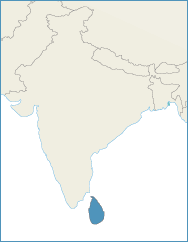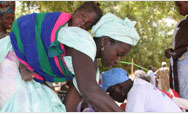 |
|
 |
 |
 |
| USAID Information:
External Links:
|
|
 |
 |
|
 |
 |
|
Sri Lanka

SNAPSHOT
Date of independence: 1948
Capital: Colombo
Population: 20 million
Annual income per person: $1,033
Source: (UNDP 2006)
USAID IN SRI LANKA
srilanka.usaid.gov
CONTACTS
Mission Director
Rebecca Cohn
USAID/Colombo
Department of State
Washington, DC 20521-6100
Tel: 94-11-247-2855
Desk Officer
Zdenek Suda
Tel: (202) 712-1115
Email: zsuda@usaid.gov

A young girl affiliated with the Eastern United Women's Organization pins a peace emblem to the uniform of a soldier in Trincomalee during commemoration of International Peace Day last September 21. "We want peace too," the soldier told the girl. (Photo: USAID)
Overview
Resumption of conflict between the Government of Sri Lanka and Liberation Tigers of Tamil Eelam and the failure to maintain a credible peace process is preventing Sri Lanka from transforming into a prosperous, stable democracy. Facilitating a return to peace and resolving the conflict through a political settlement is a major U.S. Government priority. Economically, the Western Province accounts for almost half the GDP in the country, yet a World Bank study shows that the greatest opportunity for growth will be in the conflict areas in the North and East once peace takes hold. Although the government is concerned about these “lagging regions,” the continuing conflict makes development programs challenging to implement, thereby exacerbating regional inequities. In late 2006, USAID assessed its programs in light of the conflict in order to identify the best opportunities for meaningful intervention. The result is a new program focused through a “conflict lens.” Meanwhile, programs developed in 2003 for the last five-year strategy will continue through 2008.
Programs
Through the USAID, the American government remains committed to bilateral assistance to Sri Lanka despite the escalating conflict and deteriorating security situation. Given these realities, USAID has reassessed its priorities and has developed a new strategy to deliver assistance better suited to the new dynamics of development assistance to conflict affected populations. Meanwhile, most of the programs developed in 2003 for the last five-year strategy were brought to a close in late 2007 and the remaining programs will be completed in 2008. USAID will complete its tsunami reconstruction program by Fall 2008.
The current portfolio is divided into three parts:
1. Completion of programs under the 2003-2008 strategy, including Democracy and Governance, Economic Growth, Humanitarian Assistance, and Peace Building
2. The $134 million Tsunami Reconstruction Program, including reconstruction of the Arugam Bay Bridge, reconstruction or rehabilitation of nine vocational schools, and upgrade of three fishing harbors damaged by the tsunami, construction of 85 play parks for children, and small livelihoods and infrastructure grants
3. The Development in Conflict strategy, focused on working "within" the conflict, rather than around it, centered on democracy and human rights, economic development, with focus on both conflict-strategic areas and conflict-affected populations
Development in Conflict
Since 2005 renewed conflict in Sri Lanka has resulted in the return of an institutionalized culture of violence eroding the respect for human rights, coupled with increased militarization. Hope for a permanent peace since the Ceasefire Agreement (CFA) of late 2002 took huge step back recently when on January 2, 2008, the Government of Sri Lanka abrogated the CFA. Over the past year USAID has reassessed its goals for development in Sri Lanka and created a new two-pronged strategy that addresses Sri Lanka's democratic governance and economic growth issues through the lens of the deteriorating conflict environment.
The strategy is based on the premise that economic growth can contribute to building social and economic security to help establish conditions conducive to a political solution through focusing on regional needs while also working at a national level on some of the most critical democracy, governance and conflict mitigation issues. The new Economic Growth/Workforce Development and Democracy/Governance programs will address economic disparities by expanding economic and democracy-building activity in and around the conflicted areas in Sri Lanka's North and East, and in the poorest districts in the country on the border of conflict areas.
Through regional field offices, these programs will engage with and where people are most at risk. The economic growth program will focus on private sector competitiveness, workforce development, economic revitalization via micro-enterprise, and financial sector services for the benefit of all three principal ethnic groups in the project areas in Sri Lanka. The democracy/governance strategy will avoid activities that might serve to legitimize government bodies with compromised constitutional status or a questionable adherence to democratic principles.
Here are a few highlighted USAID/Sri Lanka programs:
Sri Lanka Conflict Response Program (SCRP)
From 2008 through 2011, USAID's Sri Lanka Conflict Response Program (SCRP) will build on the successful USAID Democracy and Governance Program to address the most pressing democracy/governance issues resulting from the ongoing conflict, including human rights, media freedom and improved governance at the local level. In the medium term, the program will support government and civil society initiatives to generate support for a peaceful resolution to the conflict. The program will seek to improve human security, increase public dialogue on democracy, good governance, and the peace process, strengthen conflict mitigation and reconciliation in conflict affected populations, and enhance accountability in local governance.
Connecting Regional Economies (CORE) Program
CORE is built on the premise that economic growth programming can enhance social and economic security and help establish conditions which will underpin an eventual political solution to the conflict. Building on the Mission's successful Competitiveness Program with the private sector, from 2008 through 2011, USAID's Connecting Regional Economies (CORE) program will focus on the Eastern and to a limited extent the Northern and Northern Central provinces. The program will support livelihood development for vulnerable populations, promote competitiveness of agriculturally based regional projects, ensure groups in conflict-affected areas participate in privates sector- led value chain development, implement a workforce development program, and promote a business-enabling environment.
Humanitarian Aid
The December 2004 tsunami killed nearly 40,000 people in Sri Lanka and devastated infrastructure and livelihoods of thousands more. The $134 million Tsunami Reconstruction Program consists of projects specially targeted to spur economic growth in heretofore-overlooked sectors. Projects include construction of a $10 million bridge over Arugam Bay, a potentially lucrative tourist hub; a water supply system for a nearby community; reconstruction or rehabilitations of 9 vocational schools providing training in areas relevant for future employments; and upgrades of three damaged fishing harbors that will modernize a core engine of the economy. A coastal management component and small grants round out the programs, all of which were developed in consultation with local communities.
Back to Top ^
|


